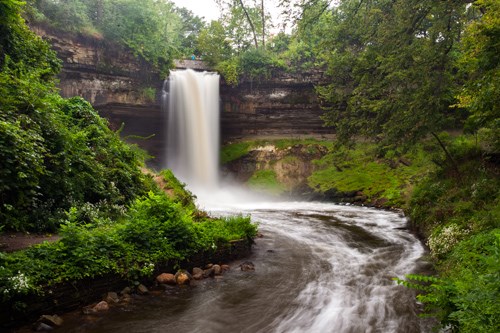 The first stop was Minnehaha Falls. This park takes its name after the beautiful stream and its spectacular falls that plunges 53 feet into a gorge before running out to the Mississippi River. The New England poet, Henry Wadsworth Longfellow, gave this Minneapolis waterfall national fame in the Song of Hiawatha, although he never saw the 53-foot falls he wrote of in 1853.
The first stop was Minnehaha Falls. This park takes its name after the beautiful stream and its spectacular falls that plunges 53 feet into a gorge before running out to the Mississippi River. The New England poet, Henry Wadsworth Longfellow, gave this Minneapolis waterfall national fame in the Song of Hiawatha, although he never saw the 53-foot falls he wrote of in 1853.From there we drove along Ford Drive, past where the former Ford plant was located, then across the Mississippi River (one of many crossings).
Next, we cruised along Summit Avenue, the longest street of preserved Victorian homes in the nation. It is a beautiful street, divided by a grassy, treed boulevard. Most of the houses on the street are large, distinctive houses built between 1890 and 1920.
 Downstairs, I found a model of the church built with Lego! The model is 5 feet long, 4 feet wide and 3 1/2 feet wide. It took about 50 hours of planning and 100 hours to build. Approx. 70,000 blocks were used to build this model. Each Lego brick is unaltered from its original from its original size and colour.
Downstairs, I found a model of the church built with Lego! The model is 5 feet long, 4 feet wide and 3 1/2 feet wide. It took about 50 hours of planning and 100 hours to build. Approx. 70,000 blocks were used to build this model. Each Lego brick is unaltered from its original from its original size and colour.For our lunch stop at 11:05, we went to "Joseph's Grill" along with several others. It started raining when we went in. We enjoyed a great lunch from an extensive delicious menu!
The rain continued as we returned to the coach.

A short drive later, we arrived at the Wabasha River Caves, which are said to be haunted. Our tour guide was "John Dillinger", who provided an entertaining history of the site.
 |
| Our Wagon master, Bill holds up "John Dillinger" |
In the 1920s, the caves were used as a restaurant and nightclub venue known as the Wabasha Street Speakeasy. The speakeasy was said to have been frequented by gangsters such as John Dillinger and Ma Barker, however there is no evidence that these visits occurred; thus, these stories are considered legend.
After the tour of the caves, "John" joined us on the coach and escorted us on a "Gangster Tour" of Saint Paul.....when the Saintly city wasn't so saintly, a bus tour that took us around town to the sights of mayhem & mystery.
Along the tour, we saw the Hamm mansion, where Hamm's, first brewed in Minnesota in 1865, is America's classic beer. Hamm's is brewed using the purest water and the choicest barley malt, grain and hops. The Theodore Hamm Brewing Company was established in 1865 when a German immigrant, Theodore Hamm (1825-1903) inherited the Excelsior Brewery from his friend and business associate, A. F. Keller, who had perished in California seeking his fortune in the gold fields. Unable to finance the venture himself, Keller had entered into a partnership with Hamm to secure funding. Upon Keller's death, Hamm inherited the small brewery and flour mill in the east side wilderness of St. Paul, Minnesota. Keller had constructed his brewery in 1860 over artesian wells in a section of the Phalen Creek valley in St. Paul then known as Swede Hollow. Hamm, a butcher by trade and local saloon owner, first hired Jacob Schmidt as a brew master. Jacob Schmidt remained with the company until the early 1880s, becoming a close family friend of the Hamms. Schmidt left the company after an argument over Louise Hamm's disciplinary actions regarding Schmidt's daughter, Marie. By 1884, Schmidt was a partner at the North Star Brewery not far from Hamm's brewery.
Our day continued with a tour of Saint Paul before returning to the park at 5:00.
No comments:
Post a Comment